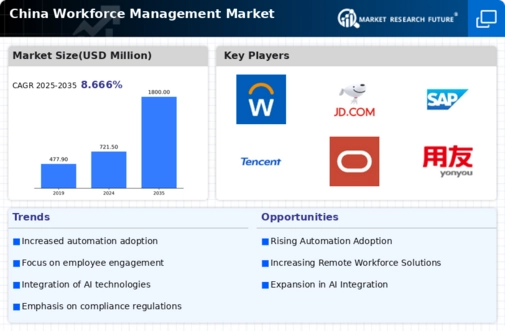The China Workforce Management Market is witnessing significant developments driven by the need for efficient employee management, productivity enhancement, and compliance with local regulations. The competitive landscape is diverse, characterized by the presence of both global and domestic players. These companies are continuously innovating to enhance their offerings and capture a larger market share. As organizations transition towards digital transformation, the demand for sophisticated workforce management solutions has risen sharply. Factors such as globalization, shifts in labor demographics, and the ongoing evolution of technology are propelling established firms to adapt and re-evaluate their strategies to maintain competitiveness.
This market environment encourages collaboration, partnership, and acquisition strategies to improve capabilities and expand product portfolios to meet varied client needs.Within the landscape of the China Workforce Management Market, Workday stands out with its strong presence and innovative approach. Workday offers a cutting-edge platform that integrates various workforce management functions, including human capital management, payroll, and talent management. Its strengths are deeply rooted in its user-friendly interface and robust analytics capabilities, which enable businesses to make informed decisions.
Workday's cloud-based solutions have garnered attention in China, particularly as organizations embrace digital solutions to foster flexibility and scalability. The ability to customize offerings to align with local labor laws and practices enhances Workday's competitive edge, making it a preferred choice among China-based enterprises looking for comprehensive workforce management solutions.JD.com has also carved out a significant niche in the China Workforce Management Market, leveraging its experience in e-commerce to offer tailored workforce solutions. The company provides various services that assist organizations in managing their human resources more effectively, including staffing solutions, labor optimization, and performance management tools.
JD.com's market presence is bolstered by its extensive logistics and supply chain capabilities, which serve as an advantage when addressing workforce management needs within these arenas. The company's engagement in mergers and acquisitions aimed at enhancing its technology stack further fortifies its position in the market. Moreover, JD.com’s emphasis on data-driven insights and automation supports organizations in maximizing efficiency and reducing operational costs, fitting seamlessly into the needs of China’s rapidly evolving business landscape, thereby reinforcing its status as a reliable partner in workforce management solutions.






















